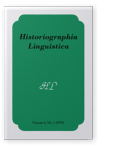Vol. 6:1 (1979) ► pp.1–14
A Seventeenth-Century Polyglot Grammar
Jean Sterpin was a Frenchman who flourished in Copenhagen in the mid-nth century. His claim to recognition rests on his polyglot grammar, Institu-tiones Glotticæ (c. l668). Sterpin was acquainted with the language philosophy of Comenius, whose Janua Linguarum (1631) had set the pattern of the polyglot genre, with the work of Nathanael Duёz (fl. 1640–78), the polyglot lexicographer-grammarian, and with Erik Eriksen Pontoppidan’s Grammatica Danica (1668). The way in which Sterpin tackles the problem of teaching the grammar of three languages (French, English and Danish) and proficiency in four (incl. Latin) is superior to the schemes employed by Beyer (1661), Howell (1662), Smith (1674), and Colsoni (1688). His method of presentation is a skilful combination of typographic variation, Vertical alternation’, and the use of parallel texts. More important still, his description of the three languages involved is effected by interlanguage comparisons. The article touches on the parts of speech, case and gender distinctions, word-order, etc, but the strong and weak points of Sterpin’s contrastive-polyglot approach are best studied in his survey of English speech-sounds. Sterpin is sparing in his use of illustrative examples, the parallels he draws are not free from ambiguity, and his sound descriptions suffer from an imperfect understanding of the organs of speech. On the other hand, he shows practical skill in tongues, and his transliterations and ‘names’ of the letters of the four alphabets are no less ingenious than the contrastive layout as a whole. Especially helpful is a table of ‘diphthongues’ and ‘triphthongues’ on the basis of which it has been possible to assign the English long vowels their relative position in the vowel tract. In addition, there are comments on vowels in weak position and on consonants.
